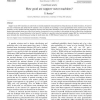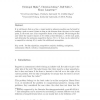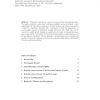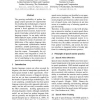26354 search results - page 164 / 5271 » How we refactor, and how we know it |
NN
2000
Springer
13 years 10 months ago
2000
Springer
Support vector (SV) machines are useful tools to classify populations characterized by abrupt decreases in density functions. At least for one class of Gaussian data model the SV ...
DAM
1999
13 years 10 months ago
1999
It is well known that on a line, a target point in unknown position can be found by walking a path at most 9 times as long as the distance from the start to the target point, in t...
IJISEC
2010
13 years 9 months ago
2010
The inherent key escrow problem is one of the main reasons for the slow adoption of identity-based cryptography. The existing solution for mitigating the key escrow problem is by a...
LPAR
2010
Springer
13 years 9 months ago
2010
Springer
This paper introduces a nested sequent system for predicate logic. The system features a structural universal quantifier and a universally closed existential rule. One nice conseq...
ACL
2010
13 years 8 months ago
2010
The growing availability of spoken language corpora presents new opportunities for enriching the methodologies of speech and language therapy. In this paper, we present a novel ap...




